Author(s): Janos Vincze* and Gabriella Vincze-Tiszay
Generally, the excitation is correlated with a local modification of the membrane potential; but if the depolarization is intense, it „propagates” and the electric features of the membrane of the entire cell change. The adaptation concept can have a narrower sphere, including only the functional, biophysical and anatomical modifications; in a wider meaning, the sphere extends to everything that represents changed functions and structures, which allow the development of life, even in extremely unfavourable environment conditions, until non lethal pathological alterations. Sexuality does not have only a reproductive biological function, but it has others as well: multiplicative, fortifying, selective, diversifying. The adaptation of organism to the life conditions is realized mainly by the adaptation of metabolism. Knowing the biophysical and biochemical regulation leads amongst others – to an even wider conception about the functions of the metabolism in the living organism.
Of the 92 elements from Mendeleev’s periodical table, over 60 of them have been found in living organisms. In terrestrial organisms: oxygen forms 70% of their mass, carbon - 18%, hydrogen 10%, calcium, nitrogen, potassium and silicon a few tenths of percentage, phosphorus, magnesium, sulphur, chlorine, sodium, aluminium, iron - a few hundredths of percentage. The four main chemical elements which enter in the composition of living matter: carbon, hydrogen, oxygen and nitrogen are found abundantly on the surface of earth where the biosphere developed [1-3]. A 70 kg adult human body contains 46 kg of oxygen, 12 kg of carbon, 7 kg of hydrogen, 1,7 kg of nitrogen, 1,1 kg of calcium, 0,6 kg phosphorus, 0,3 kg of potassium, 0,2 kg of sodium, 0,15 kg of sulphur, 0,1 kg of chlorine, 35 g of magnesium, 5 g of fluorine and 3-4 g of iron. There 13 elements form together 99,99% of the entire mass of the organism. The feeble difference up to 100% is due to the presence of oligoelements, which are given an important role today [4,5].
Research on the human locomotion has been performed by Borelli (1682). but the scientific determinations in human kinematics start with Marey in the year 1860. The chronophotographic method, used by this French physiologist consists of taking a series of instantaneous photographs at equal and small intervals.
The concept of excitation was introduced in medicine by J. Brown in his book “Elementa medicinae” (1778), as a fundamental property of living matter. The modern biophysics concept constitutes a synthesis of molecular biology data and contemporary electrobiophysics. The excitation is in this concept a primary functional manifestation inside the cellular membrane. Secondary, there are cytoplasm processes taking place: contraction, secretion. Due to this unequal repartition of ions, the cellular membrane is “polarized”, with a potential difference of 70-80 mV for the nerve and muscular cell [6,7].
Generally, the excitation is correlated with a local modification of the membrane potential; but if the depolarization is intense, it “propagates” and the electric features of the membrane of the entire cell change. The action current appears with a quite complex aspect.
Through recordings of the action potentials - EKG, EEG, EMG, ERG - in various conditions: today one can investigate successfully in the experimental research the excitation processes in the main living structures. The data supplied through these biophysical methods are used in the medical diagnostic [8].
The organisms must adapt their function and structures to the changing and renewing realities of the environment every moment during their entire existence, thus obtaining their preservation as beings, as populations, as species.
The adaptation concept can have a narrower sphere, including only the functional, biophysical and anatomical modifications; in a wider meaning, the sphere extends to everything that represents changed functions and structures, which allow the development of life, even in extremely unfavourable environment conditions, until non lethal pathological alterations [9].
The adaptation to the environment, in the wide meaning accepted in biology is the complex defence mechanism from the solicitations determined by the changes of the environment, to new existing conditions; it consist of the totality of morpho-functional modifications proper to the living organism, which finally achieve higher levels of evolution, becoming more capable of survival than in their previous phases of existence.
The man’s adaptation is tightly connected to its health state which depends, among other things, of the capability and method of achieving the adaptation. From the point of view of public health, the adaptation to the environment is a positive result, consisting of the strengthening of the physiological functions and the proper development of bodies, while the inadaptation means disease or death.
Sexuality is a very characteristic process of the living organisms. In the sexual reproduction, we find two sexually polarized cells (gametes) each with a halved number of chromosomes (a single set, haploid cells) coming generally from different individuals, which merge (through fecundation) in a single egg. The egg will produce a new organism, with a complete number of chromosomes (two sets, diploid cells) [10]. This means, among other things, a certain separation and reunion of active molecules, first of all of nucleic acids. The chromosomal localization allowed the elaboration of cytological mechanisms of preservation, repartition and growth of the amount of hereditary information, which had a great importance for evolution. The sexual process implies in itself the possibility of numeric multiplication of these units. Sexuality does not have only a reproductive biological function, but it has others as well: multiplicative, fortifying, selective, diversifying.
What is aging? The main theories about aging are biophysical, cellular, tissue related, visceral and humoural.
The biophysical theories stress some modifications such as hydrations, alteration of colloidal mixtures, decrease of the nuclein amount, structural modifications in proteins, inactivation of biocatalysts, decrease of cellular electric resistance, decrease of the mitogenetic radiant power, decrease of the membrane permeability.
Cellular theories explain aging by: chromosomal alterations, alteration of the nucleus - plasma ratio, the hindering of nucleus - plasma changes, the decrease of the vegetative protoplasm through differentiation and accumulation in paraplasm, alterations in mitochondria, in ribosomes and centriols. Tissue related theories applicable to pluricellular organisms make the biological insufficiency (on behalf of wear) of a certain organ, system or tissue responsible for the aging of the entire organism [11].
In a broad biological perspective, death and aging itself are an indispensable condition of the evolution of life on earth, making room” to the repeated development of the competition between individuals and the repeated selection of the most qualified ones
The most important characteristic of living matter is represented by the exchange of substances between organism and the environment. The adaptation of organism to the life conditions is realized mainly by the adaptation of metabolism. The environment is an indispensable condition of life (the organism is an opened system), but it is also a continuous threat of the integrity of the living structural integrity. The metabolism of the substances and energetic metabolism represent essentially a unique process. They are inseparable because there is not such thing as a metabolism of substances without energy modification and an energetic metabolism cannot exists without a substance metabolism [12].
Knowing the biophysical and biochemical regulation leads amongst others - to an even wider conception about the functions of the metabolism in the living organism. Classically, it is admitted that the metabolism can be constructive (plastic) - leading to neoformation of living matter or the formation of necessary structures in the architecture of organisms (skeleton, cellulose membrane etc.) [13]. It can also be energetic - leading to the freeing of the necessary energy for various vital functions and also for synthesis. Within the energetic metabolism there is the synthesis of compounds which embed the chemical energy (ATP, glycogen, fats etc.). But the metabolic activity also includes processes which are essential for the defence from the environment and the substance transformation leads also to important chemical products for the adjustment of the organism, for insuring its best functioning conditions (adaptation metabolism).
Metabolism represents a form of matter circulation in nature. The circuit of the matter in the living world is characterized by the fact that during the cycles of the various elements (C, O, N, P, S, Ca etc.) the phylogenetic evolution of the organism also takes place, leading to new types of metabolism, hence it changes the details of the matter circuit [14]. The metabolism is the basic limit criteria between the structure of the unloving and living organism; if a living structure does not show any form of metabolism, then it loses its viability.
The functioning of the living systems without exception is based on the use of chemical energy, hence they must have chemical “motors” capable of a continuous use of energy through some chains of autocatalytic cyclic reactions [15,16].
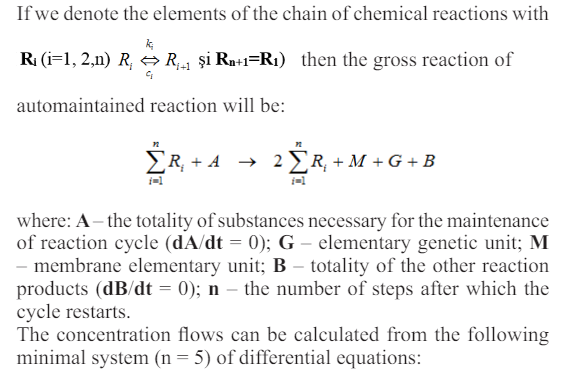
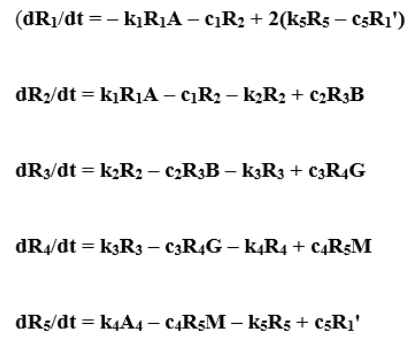
Next, we will show that the cycle of this regenerative autocatalytic reaction characterized by this system of differential equations represents a model which stimulated certain criteria of life. The simulation of the metabolism emerges obviously from the expression of the gross reaction, since the cycle consumes permanently substances (A) taken from the environment, which it transforms in its own constitutive elements and free the other products in the environment (B).
In the case of the living organism the functioning of the system is assured by the chemical engine” of the metabolism, whose premise is that the amount of the energetic content (free enthalpy) of the nutritive substances must be greater that the sum of the energetic content of the products [17]. Some products resulted can have a higher energetic content that any of the exogene substances consumed, if compensated by the decreased energetic content of the other products.
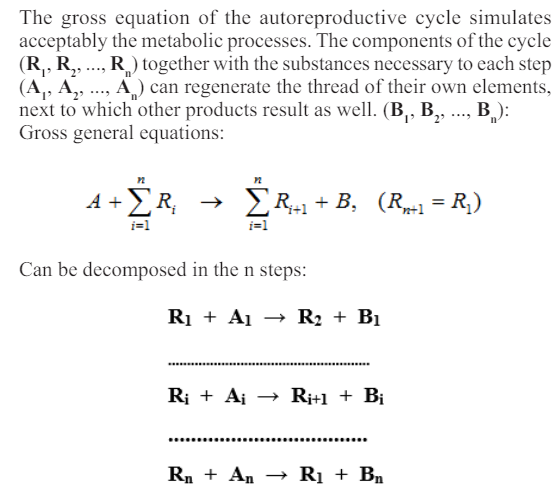
From the moment of apparition of life, the metabolic processes modified significantly: the metabolism preceded the apparition of enzymes but now it cannot be conceived without them. Through the metabolic processes, the organic bond between parts and whole within living creatures as well as the concordance between structure and function are achieved.
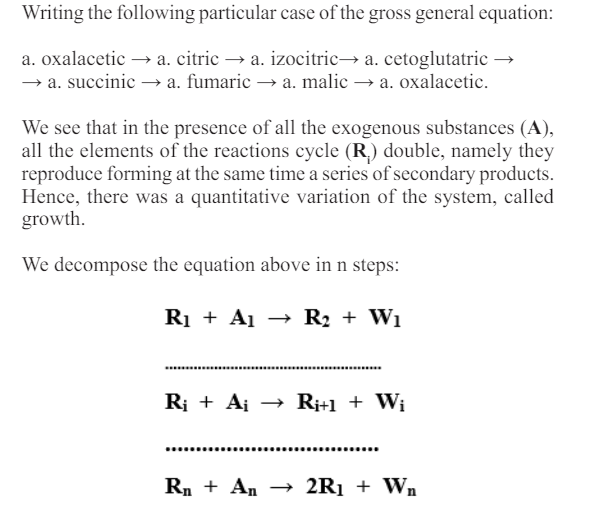
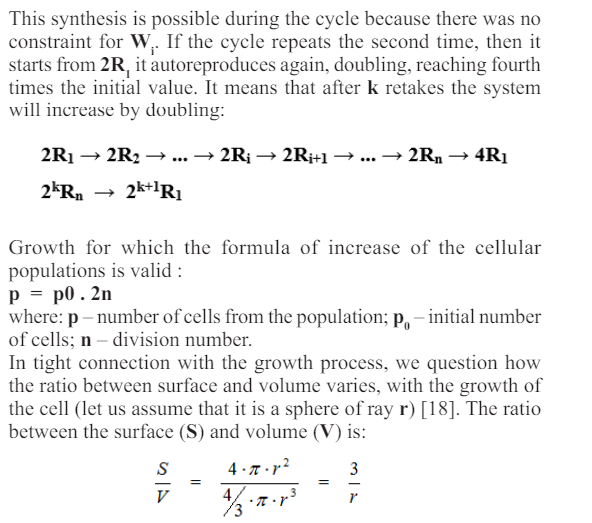
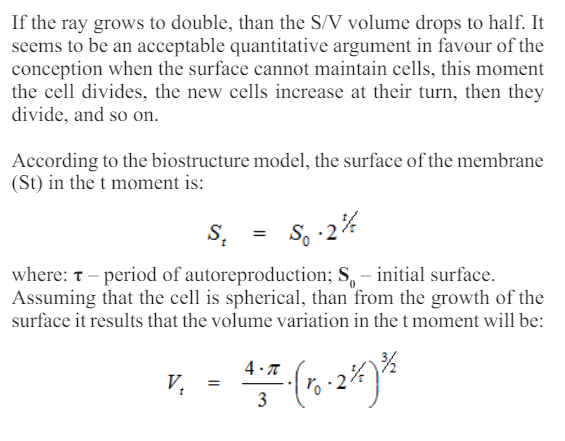
where: r0 - is the initial ray from the moment t0. Thus, to the double cellular volume does not correspond a double surface, but a smaller one, since the volume varies proportionally with the cube of the ray and the surface only with the square of the ray.
The reproduction is the capacity of living systems to generate descendants similar to them. It ensures the perpetuation of the species dispite the individual life and at the same time it is the link between the following generations.
1. Vincze J (1971) About the Transport Phenomena. First Europ. Biophys. Cong. Baden 45: 48.
2. Vincze J (1972) The transport phenomena in the Human Organism. IVth Intern. Biophys. Cong. Moscow https:// www.goodreads.com/book/show/59034173-the-biophysical- modeling-of-the-transport-phenomena-in-the-human-organis.
3. Vincze J (1984) The Cross-effect in the Living Systems. Med.P. Budapest 4: 134-140.
4. Vincze J (2015) The Capital Chapter of the Biophysics. 5th Edition, NDP P. Budapest.
5. Vincze J (2007) Interdisciplinarity. NDP P, Budapest.
6. Vincze J (2001) The Transport Phenomena and Cross-effects in the Living Systems. NDP P Budapest.
7. Vincze J (2018) Medical Biophysics. NDP P.,Budapest.
8. Vincze J (2020) Biophysics of the Apparatuses. NDP P. Budapest 7: 39173-39176.
9. Vincze J (2021) The Biophysical Modeling of the Apparatuses in the Human Organism. Lambert Academic Publishing, Berlin 5: 23-26.
10. Vincze J, Vincze-Tiszay G (2020) The Biophysics is a Borderland Science. Roum. J. Appl. Scien. Tech 3: 115-121.
11. Vincze J, Vincze-Tiszay G (2020) Some Aspects of Sciences from the Biophysical Point of View. Int. J. Software & Hardware Engin 8: 103-108.
12. Vincze J, Vincze-Tiszay G (2020) The Biophysical Adjustment in the Human Organism. J.Med. Res. Case Reports 3: 1-7.
13. Prigogine, I., Balescu V.: The Physicists Conception of Nature, Boston, 1973.
14. Vincze J, Vincze-Tiszay G (2020) The Biophysical Modeling of the “Seven-Dimensional” Man. Int. J. Recent Sci. Res 5: 123-130.
15. Vincze J, Vincze-Tiszay G (2020) The Biophysical Modeling of the Different Regulation in the Human Organism. Int.J.Innov. Stud. Med. Sci 1: 1-5.
16. Vincze J, Vincze-Tiszay G (2022) The Biophysical Modeling of Transport Phenomena and of Crossing-effects in Living Organism. Research Aspects in Bioéogical Sciences 4: 48-56.
17. Vincze J, Vincze-Tiszay G (2023) The Biopsical Modeling of Psychological Aspects. Advances Social Sciences Research J 9: 90-97.
18. Vincze J, Vincze- Tiszay G (2023) The Human Mind. Philosophy Study 13: 60-66
View PDF